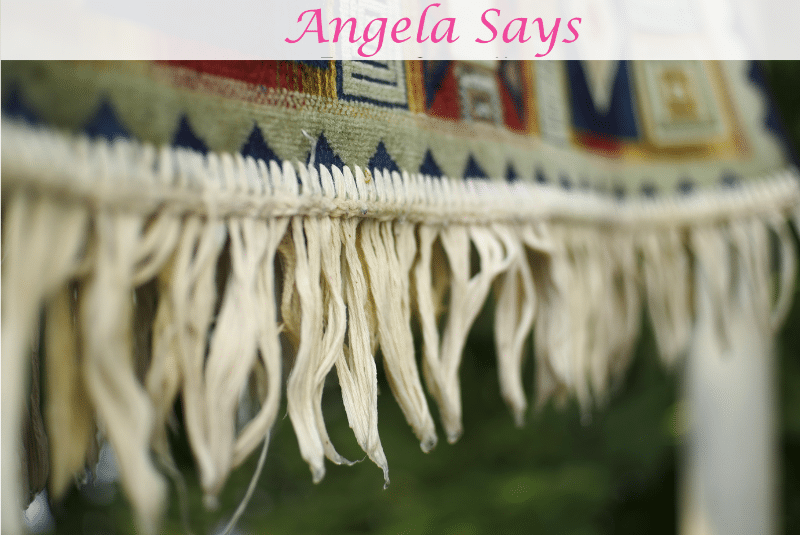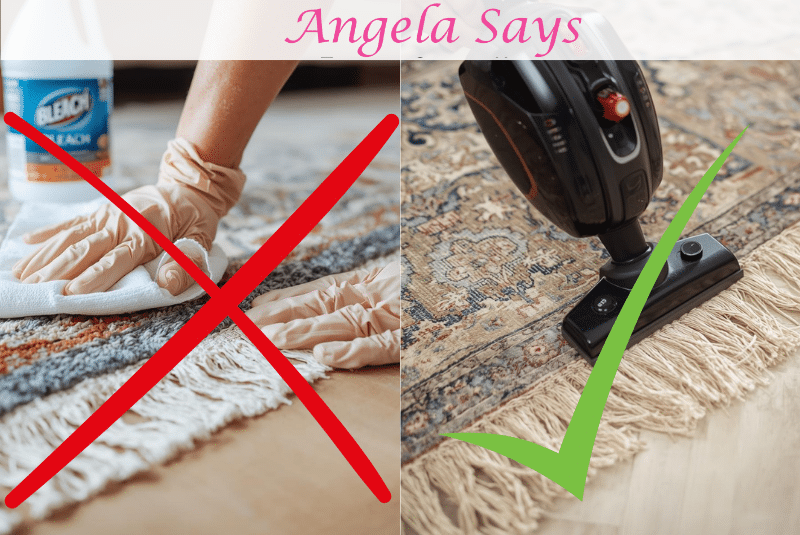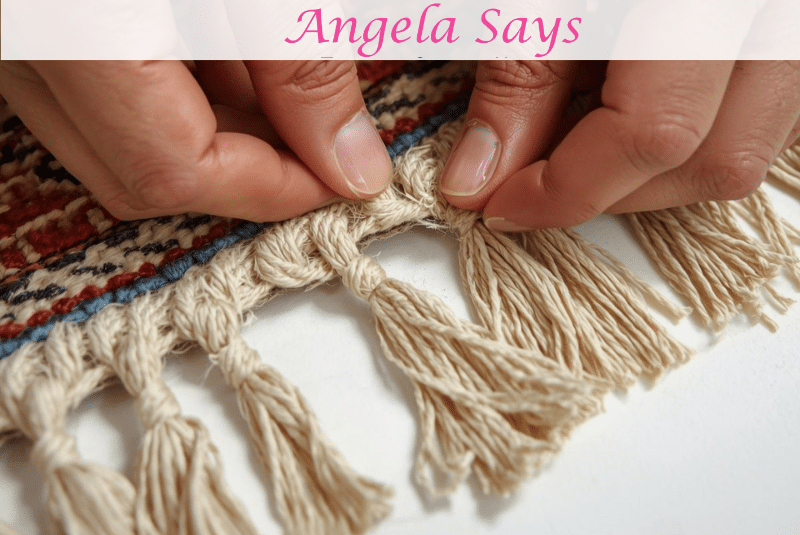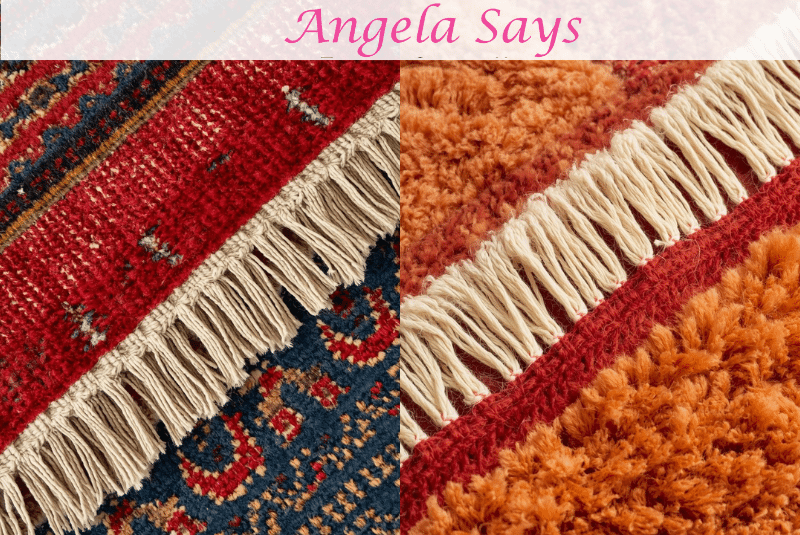Fringe Care: Brightening Without Bleach

The Secret Life of Fringes
Fringe is one of those quiet details that can completely transform a textile. Whether it frames a handwoven rug, edges a vintage throw, or finishes the hem of luxurious drapery, fringe gives motion, texture, and an artisanal touch. Yet, for all its charm, it’s also the part most prone to dullness, tangles, and wear. Over time, gravity, dust, and light exposure all take their toll, turning bright tassels into limp, uneven threads that make even the most beautiful fabric look tired.
Many people think the solution is simple: bleach it. But that’s where the trouble begins. Fringes are often made from delicate fibers, such as cotton, silk, or wool, that don’t respond well to harsh chemicals. A splash too much, and what was once a crisp white fringe can yellow, fray, or even dissolve over time. Professionals know that true brightness doesn’t come from stripping fibers; it comes from reviving them.
At the same time, brightening is only half the story. Even perfectly clean fringes can lose their rhythm; those evenly spaced tassels that once hung straight begin to twist, sag, or clump together. This is where the art of re-tensioning comes in. Textile restorers and rug professionals have quiet mastery over this craft, using water, weight, and patience to coax each tassel back into harmony.
In this post, we’ll explore how experts keep fringes fresh and luminous without ever reaching for bleach and how they restore structure to tired tassels using traditional, fiber-friendly methods. With the right care, those fine threads at the edge of your fabric can stay as graceful and bright as the day they were woven.
Why Bleach Isn’t the Answer

Bleach has long been the go-to solution for whitening textiles, but when it comes to fringe, it’s often the beginning of the end. The very quality that makes bleach so effective at removing stains is what makes it destructive to delicate fibers. It doesn’t clean so much as it strips. And in the world of finely spun cottons, silks, and wools, that’s a recipe for irreversible damage.
The Chemistry of Destruction
At its core, bleach works by breaking down the chemical bonds that create color. Unfortunately, those same oxidative reactions can also attack the cellulose or protein structure of the fibers themselves. On cotton, bleach weakens the cellulose chains, making them brittle and more likely to snap. On silk or wool, both protein-based fibers, it essentially “burns” the fiber, eating away at the surface and dulling the natural sheen. What’s left is a rough, lifeless texture that no amount of conditioner can revive. Even when bleach appears to work, it can leave behind subtle traces of damage that worsen over time:
- Yellowing: Iron residues and chlorine byproducts react with air, turning “bright white” into a creamy, uneven hue.
- Fraying and thinning: Fringes lose their twist and strength, leading to stray threads or broken tassels.
- Fiber fatigue: Overbleached fringe tends to attract more dirt due to the roughened surface, making it dull faster than before.
The Shift Toward Smarter Solutions
Modern textile conservation has shifted toward sustainable, non-destructive brightening. Neutral pH cleansers, oxygen-based agents, and gentle mechanical cleaning can achieve a clean, radiant finish without compromising the fabric’s lifespan. The goal is no longer to make fibers “whiter” at all costs; it’s to make them naturally luminous, restoring the optical brightness they were meant to have.
Brightening Without Bleach: Pro-Approved Techniques
The best textile restorers know that brightness isn’t achieved by stripping away color; it’s achieved by reviving light reflection. Clean, healthy fibers naturally reflect light more evenly, creating that luminous, “just woven” glow. Here’s how professionals accomplish that clarity safely, without bleach or harsh oxidizers.
a. The Dry Brighten Approach
When fringes look dull but not deeply soiled, professionals start with the gentlest method: dry brightening. This process focuses on lifting surface dust and micro-grime that clouds the fiber’s surface, often without any immersion.
- Micro-vacuuming: Using a low-suction nozzle covered with a fine mesh, pros remove embedded dust without pulling at the tassels.
- Oxygen-Based Brighteners: A mild solution of sodium percarbonate (the active ingredient in many “eco-bright” cleaners) releases oxygen when dissolved in water. This gently breaks down organic residues that dull white fibers.
- Dilution & Control: The key is moderation, a 1–2% solution used with controlled soak times brightens without stress. Overexposure can make fibers chalky, so pros often rinse and neutralize with distilled water immediately afterward.
The result? Fringes that look refreshed, not bleached, the kind of clean that reveals the fabric’s natural tone instead of forcing a false white.
b. Natural Fiber RevivalFor heritage textiles or handmade pieces, the safest route is often found in nature. Many professionals and at-home caretakers rely on simple, pH-balanced solutions that revive luster without chemical aggression.
- Vinegar Rinse: A capful of white vinegar in a basin of cool water helps neutralize alkaline residues from soaps, restoring softness and shine.
- Baking Soda Pre-soak: When mixed properly (½ teaspoon per liter of warm water), baking soda loosens soil and deodorizes without altering fiber chemistry.
- Lemon or Hydrogen Peroxide Boost: For a natural brightening lift, a drop of lemon juice or a low-concentration hydrogen peroxide bath mimics sunlight’s optical whitening, minus the fiber burn.
After treatment, textiles should be blotted (never wrung) and dried flat in indirect sunlight. Professionals favor filtered daylight, which activates natural optical brighteners in the fiber but avoids UV damage.
c. Professional Textile Washes
When fringe discoloration runs deeper, perhaps from years of use or contact with flooring professionals, turn to neutral pH textile washes.
- Neutral Detergents: Products formulated specifically for conservation (like Orvus WA Paste or WoolSafe detergents) cleanse without stripping fiber oils.
- Controlled Submersion: Fringes are either fully immersed (for removable pieces) or gently brushed with foam to minimize water absorption into the base fabric.
- Precision Rinsing: A distilled water rinse ensures no mineral deposits remain to dull brightness later.
- Air Drying Under Weight: Tassels are laid straight under a light press or a tension bar, allowing gravity to naturally realign fibers as they dry.
This combination of chemistry and care produces brightness that lasts, not a flash of white that fades, but a clean radiance that stays resilient wash after wash.
d. The “Less Is More” Rule
Across all professional techniques, restraint is the golden rule. Overcleaning is just as harmful as neglect. Gentle, periodic care — every few months rather than every few weeks- keeps fibers strong and color stable. When fringe is treated as part of the fabric’s living structure, rather than an expendable decoration, it rewards you with durability and beauty that age gracefully.
The Art of Re-Tensioning Tassels

Even after the brightest clean, fringes can lose their rhythm, and tassels begin to twist, curl, or sag unevenly —a quiet sign that the fibers have relaxed and lost their original alignment. Restoring this balance requires more than just patience; it’s a form of textile choreography known among professionals as re-tensioning. Done correctly, it brings structure, movement, and symmetry back to every strand.
a. Why Tension Matters
Tension gives tassels their grace. Each fringe strand depends on uniform pull to hang straight and reflect light evenly. Over time, gravity, humidity, and handling stretch some threads more than others. Moisture from cleaning or ambient air can further soften fibers, allowing them to twist or clump.
Professionals view re-tensioning as both a technical and aesthetic task. It’s about returning the fiber to its “neutral state”: relaxed but aligned. When done properly, tassels regain that crisp fall and gentle sway that signals quality craftsmanship.
b. Step by Step: Re-Tensioning Like a Pro
1. Preparation
Begin by lightly misting the fringe with distilled water. This softens fibers and allows them to realign without stretching. Avoid full saturation; the goal is pliability, not dampness.
2. Untangling
Using a soft toothbrush, wide tooth comb, or bamboo skewer, gently separate each tassel from root to tip. Always work in the direction of the twist. For silk or fine cotton, pros sometimes apply a diluted neutral pH conditioner to prevent static and fiber friction.
3. Realigning
Lay the fringe flat on a clean towel. Secure the textile base with gentle weights or clips, then align tassels vertically. Professionals may hang the piece so gravity assists the process, attaching light fishing weights or using a frame to guide the fibers into even tension.
4. Drying & Setting
Allow the tassels to air-dry naturally in a ventilated space. Avoid heat sources, as they can over-tighten fibers and distort shape. Once dry, comb again lightly to reinforce alignment.
A common conservator’s trick: use a slight steam pass (from a safe distance) to “set” the fall of the tassel without making it stiff.
5. Finishing Touch
For static control or a touch of softness, apply a fine mist of fabric refresher or diluted conditioner. Some restorers use an anti-static textile spray designed for museum textiles; it keeps tassels flowing freely without attracting dust.
c. When to Seek Professional Help
If the fringe is antique, brittle, or color-sensitive, attempting re-tensioning at home can cause more harm than good. Professional restorers use blocking frames, micro steamers, and pH-neutral softeners calibrated to fiber type. They can also retwist or rebind damaged tassels, resecuring them to the textile base without altering the weave.
Fringes that are discolored, unevenly dyed, or dry-rotted may require partial reconstruction. In such cases, textile experts match replacement yarns to the original, ensuring seamless blending and maintaining the textile’s historic or aesthetic integrity.
d. The Philosophy Behind the Practice
Re-tensioning isn’t just about appearance; it’s about respect for the textile. Each tassel, once realigned, tells a story of care and craftsmanship. Where bleach strips and forces, tensioning restores and balances. Professionals often describe it as “listening to the fiber,” moving slowly enough for the material to guide the process.
In the end, well-tensioned tassels do more than hang neatly; they frame the textile with grace, turning edges into statements of skill and patience.
Prevention: Keeping Fringes Bright and Balanced

The best fringe care isn’t reactive, it’s preventive. Once fibers begin to yellow, fray, or tangle, even the most skillful restoration can only do so much. The goal is to keep tassels in their best state for as long as possible by building simple, consistent care habits into your routine. These small rituals preserve both brightness and tension, allowing your textiles to age gracefully and beautifully.
a. Dusting and Routine Cleaning
Dust is the quiet enemy of fringe. Over time, fine particles settle into fibers, dulling color and encouraging tangling.
- Regular Dusting: Every week or two, lightly brush fringes with a soft, dry paintbrush or use a low-suction vacuum fitted with a mesh screen. This removes debris without pulling or fraying.
- Dry Wash Maintenance: For rugs, rotate them regularly to prevent one side of the fringe from bearing the brunt of foot traffic or sunlight.
- Spot Care: If a spill happens, blot immediately with a dry cloth. Avoid rubbing it pushes dirt deeper into the fibers and disrupts tassel alignment.
Consistency here is everything. Gentle, frequent upkeep prevents buildup that can lead to discoloration and uneven tension later on.
b. Protecting from Light and Air Damage
Fringes, especially those on curtains or throws, live in constant contact with air and light both of which can alter fiber chemistry over time.
- Sunlight Rotation: Rotate textiles seasonally to even out UV exposure. Direct sun can yellow or weaken fibers, especially in natural materials like silk or cotton.
- Filtered Light: Use sheer drapes or UV-protective window films to minimize damage.
- Air Quality: Smoke, cooking vapors, and urban dust all leave micro-residues that dull brightness. Keep textiles away from kitchens or open windows when possible.
c. Moisture and Humidity Control
Humidity is a quiet but powerful force on fringe fibers. Too much, and tassels relax, sag, or attract mold; too little, and they become brittle.
- Ideal Conditions: Maintain indoor humidity between 40–60%.
- Avoid Over-Misting: While occasional re-tensioning uses water, daily exposure weakens the base.
- Storage Tips: If storing textiles, roll them with acid-free tissue and wrap the fringe separately in a breathable cotton cover to prevent tangling and creasing.
d. Fabric Guards and Protective Finishes
Many professional conservators apply fabric-safe protectants to repel dirt and moisture. Unlike commercial sprays, these are neutral in pH and designed for heritage preservation.
- For home care, choose a non-silicone-based textile protector.
- Always test first on an inconspicuous section; some products can alter fiber sheen.
- For antique pieces, skip chemical coatings altogether and rely on proper environmental control instead.
e. Mindful Handling
Even clean, bright fringes can lose structure through frequent touching or careless movement.
- Always lift rugs or throws instead of dragging them.
- When cleaning, support the fringe at the base rather than pulling from the ends.
- For curtains, tie or braid fringes loosely during storage to prevent tangling without creasing.
Handled with care, fringe can remain perfectly aligned for years, aging into a soft, elegant drape rather than a tangled edge.
f. Routine Refresh Schedule
- Light Dusting: Weekly
- Spot Cleaning or Realignment: As needed
- Deep Cleaning or Professional Re-Tensioning: Once or twice a year
This rhythm mimics how professional restorers maintain museum-grade textiles, with frequent micro-care and rare deep interventions. It’s a sustainable approach that honors both the craft and the material.
The Takeaway
Preventive care is a conversation with the fabric subtle, continuous, and respectful. The goal isn’t to keep fringe looking new forever; it’s to help it look well-kept and alive. With mindful handling and the right environment, even the most delicate tassels will retain their luminosity and poise, reminding you that true luxury lives in the details.
Expert Insights & Conclusion: The Beauty Is in the Details
Professional rug restorers often say that fringe tells the truth about a fabric’s care. You can clean a rug or press a curtain, but if the tassels are dull, uneven, or lifeless, the whole piece loses its magic. Caring for fringe isn’t just maintenance; it’s preservation of craftsmanship, texture, and the quiet artistry that defines fine textiles.
a. Wisdom from the Workshop
Experienced conservators approach fringe care with the same reverence they bring to antique embroidery or tapestry repair. As one restoration specialist once put it:
“Never twist a tassel dry moisture is your ally, not your enemy. Fibers must be persuaded back into line, never forced.”
This gentle philosophy underpins every pro technique. Whether using oxygen brighteners or re-tensioning weights, professionals move slowly and deliberately, allowing fibers to return to equilibrium. Their goal is not perfection, but harmony, restoring the piece to a state where color, texture, and structure coexist naturally.
b. Craft Over Chemicals
In an age of instant solutions, bleach and quick fixes promise fast results but leave long-term scars. True fringe care leans on observation, not aggression. Professionals use sight, touch, and even sound, the whisper of dry tassels or the soft swish of properly tensioned threads, to gauge condition.
These nuances are what separate cleaning from conservation. Anyone can wash a textile; few can listen to what the fibers need. And that’s where beauty endures in the decision to care rather than correct.
c. Living Textiles, Lasting Impressions
Fringe, like any natural fiber, evolves. It softens, shifts, and gains character with time. With mindful care, those tassels won’t just stay clean; they’ll tell a story of touch and attention. A rug fringe that falls evenly years after purchase, or drapery edges that still shimmer softly in filtered light, reflect not only the fabric’s quality but also the patience of its keeper.
The reward for such care is quiet but profound: a textile that remains alive, responsive, and graceful long after its peers have dulled.
Because in the end, the beauty of fringe lies not in its perfection, but in its preserved craftsmanship brightened by time, tensioned by care, and framed by respect.
Final Thoughts: From Edge to Elegance
Fringe is often the first thing to fray and the last thing most people think to protect. Yet for textile lovers and interior enthusiasts alike, caring for those delicate tassels is what separates routine upkeep from true craftsmanship appreciation. Every strand, twist, and knot carries the fingerprint of its maker, and preserving it is as much an act of respect as it is of restoration.
The journey of fringe care —from brightening without bleach to mastering the art of retensioning —reminds us that textiles are living art forms. They breathe, shift, and age, reflecting both the passage of time and the hands that maintain them. Whether you’re tending to a family heirloom rug or a contemporary throw, the approach remains the same: gentleness, patience, and precision.
Professionals may have access to advanced tools and conservation-grade cleansers, but the essence of great care lies in mindfulness. It’s about noticing the early signs of wear, respecting the material’s limits, and understanding that longevity comes from balance — not from overcleaning, but from ongoing stewardship.
So next time you pass your fingers along the fringe of a beloved textile, pause for a moment. Look closely at how it catches the light. That soft gleam, that even falls, it’s not just clean fiber. It’s the quiet reflection of every thoughtful gesture you’ve made to keep it alive.
Because true elegance doesn’t end at the edge; sometimes it begins there.
Golden Rules
- Never bleach. Choose oxygen,based or natural brighteners instead.
- Handle when damp, not dry. Fibers respond better to gentle reshaping.
- Avoid heat and harsh light. Air,dry and store away from direct sun.
- Respect the base fabric. Always support the textile when cleaning the fringe.
- Patience is preservation. The slower you work, the longer it lasts.
Closing Thought
Caring for textiles is caring for stories, and each fringe you preserve adds another strand to that shared narrative. So keep brightening, straightening, and learning. The art of care lives in your hands.
Frequently Asked Questions (FAQ)
1. Can I ever use bleach on fringe if it’s badly stained?
It’s rarely advisable. Even “color-safe” bleaches can weaken fibers and cause yellowing. Try oxygen-based cleaners first, or consult a professional textile cleaner who can isolate stains without damaging the fibers.
2. How can I tell what my fringe is made of?
Natural fibers such as cotton or wool feel soft and matte, while synthetic ones (like rayon or polyester) have a slight sheen and smoother texture. When in doubt, a professional can perform a quick fiber burn or a microscope test to confirm the composition before cleaning.
3. Is sunlight good for brightening the fringe naturally?
Indirect sunlight helps revive brightness, but direct UV exposure can degrade and yellow fibers over time. Always dry fringes in filtered or shaded light rather than full sun.
4. What’s the best way to prevent tassels from tangling?
After cleaning or brushing, lightly twist each tassel in its natural direction while still slightly damp. Let them dry vertically or under light tension. You can also loosely braid or wrap them in tissue during storage.
5. My fringe looks uneven after drying what went wrong?
Uneven drying or over,wetting can distort tension. To correct it, mist the area with distilled water, gently realign tassels, and allow them to dry under light,weight or tension clips.
6. How often should I professionally clean or re,tension my fringe?
Once a year is ideal for decorative pieces; more frequently for rugs in high,traffic areas. Preventive dusting and gentle alignment between deep cleans extend the time between professional treatments.
7. Are natural brighteners safe for colored fringe?
Generally, yes, but always patch test. Lemon and baking soda solutions can shift dyes on certain silks or vegetable-dyed fibers. If color fastness is uncertain, stick with neutral pH and color-safe detergents.
8. Can I restore antique fringe myself?
Only superficially. For antique or brittle textiles, avoid water, cleaning agents, and tensioning altogether. Instead, dust gently with a soft brush and consult a textile conservator for any deeper restoration.
